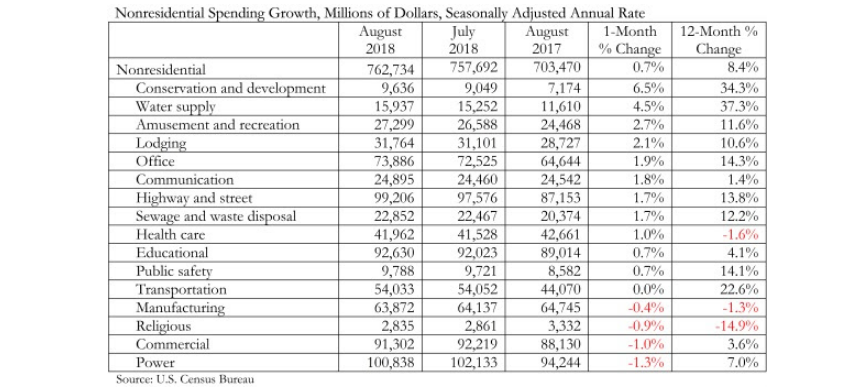National nonresidential construction spending expanded 0.7% in August to its highest level since the U.S. Census Bureau began the data series in 2002, according to an Associated Builders and Contractors analysis released today.
Total nonresidential spending stood at $762.7 billion on a seasonally adjusted, annualized rate in August, which represents an increase of 8.4% compared to one year ago. Private nonresidential spending fell 0.2% in August largely due to a 1.3% decline in power-related spending, the largest private construction spending category, and public nonresidential spending increased 2%.
“The good news on the nation’s economy and the construction sector just keeps coming,” said ABC Chief Economist Anirban Basu. “The increase in overall nonresidential construction spending was reasonably predictable given the predominance of positive leading indicators such as ABC’s Construction Backlog Indicator, which reported record-setting 9.9 months of backlog in the second quarter of this year, and the Architectural Billings Index. In addition, the recent pattern of stable private construction spending coupled with growing public spending remained in place in August.

“Rising property values, ongoing rapid job creation and a confident consumer translates into rising real estate values, income and retail sales tax collections, which in turn creates additional resources to invest in infrastructure,” said Basu. “That helps explain the chunky year-over-year spending increases in a number of primarily publicly financed categories, including water supply, which increased 37%; conservation and development, 34%; transportation, 23%; and highway/street, 14%.
“It is quite possible that construction spending growth will accelerate from current levels,” said Basu. “Aside from the strong economy, ongoing increases in materials prices and worker compensation is translating into rising project delivery costs, which, all things being equal, produces faster construction spending growth.
“For now, rising construction and borrowing costs are not stifling economic activity,” said Basu. “However, purchasers of construction services may be increasingly inclined to postpone projects if costs continue to rise, which is likely. And while contractors remain concerned about the overall construction workforce shortage negatively affecting project deadlines, the near-term outlook remains robust.”
Related Stories
Standards | Jun 26, 2023
New Wi-Fi standard boosts indoor navigation, tracking accuracy in buildings
The recently released Wi-Fi standard, IEEE 802.11az enables more refined and accurate indoor location capabilities. As technology manufacturers incorporate the new standard in various devices, it will enable buildings, including malls, arenas, and stadiums, to provide new wayfinding and tracking features.
Contractors | Jun 26, 2023
Most top U.S. contractors rarely deliver projects on time: new study
About 63% of leading U.S. contractors are delivering projects out of schedule, according to a survey of over 300 C-suite executives and owners in the construction industry by XYZ Reality. The study implies that the industry is struggling with significant backlogs due, in part, to avoidable defects, scan, and rework.
Green | Jun 26, 2023
Federal government will spend $30 million on novel green building technologies
The U.S. General Services Administration (GSA), and the U.S. Department of Energy (DOE) will invest $30 million from the Inflation Reduction Act to increase the sustainability of federal buildings by testing novel technologies. The vehicle for that effort, the Green Proving Ground (GPG) program, will invest in American-made technologies to help increase federal electric vehicle supply equipment, protect air quality, reduce climate pollution, and enhance building performance.
Office Buildings | Jun 26, 2023
Electric vehicle chargers are top priority for corporate office renters
Businesses that rent office space view electric vehicle (EV) charging stations as a top priority. More than 40% of companies in the Americas and EMEA (Europe, the Middle East and Africa) are looking to include EV charging stations in future leases, according to JLL’s 2023 Responsible Real Estate study.
Laboratories | Jun 23, 2023
A New Jersey development represents the state’s largest-ever investment in life sciences and medical education
In New Brunswick, N.J., a life sciences development that’s now underway aims to bring together academics and researchers to work, learn, and experiment under one roof. HELIX Health + Life Science Exchange is an innovation district under development on a four-acre downtown site. At $731 million, HELIX, which will be built in three phases, represents New Jersey’s largest-ever investment in life sciences and medical education, according to a press statement.
Sports and Recreational Facilities | Jun 22, 2023
NFL's Jacksonville Jaguars release conceptual designs for ‘stadium of the future’
Designed by HOK, the Stadium of the Future intends to meet the evolving needs of all stadium stakeholders—which include the Jaguars, the annual Florida-Georgia college football game, the TaxSlayer.com Gator Bowl, international sporting events, music festivals and tours, and the thousands of fans and guests who attend each event.
Contractors | Jun 22, 2023
Chris Averill named President of Pepper Construction Group
Pepper Construction Group is pleased to announced the promotion of Chris Averill to the position of President. In his new role, Averill will assume leadership responsibility for the Pepper Construction Group’s growth and performance.
Industrial Facilities | Jun 20, 2023
A new study presses for measuring embodied carbon in industrial buildings
The embodied carbon (EC) intensity in core and shell industrial buildings in the U.S. averages 23.0 kilograms per sf, according to a recent analysis of 26 whole building life-cycle assessments. That means a 300,000-sf warehouse would emit 6,890 megatons of carbon over its lifespan, or the equivalent of the carbon emitted by 1,530 gas-powered cars driven for one year. Those sobering estimates come from a new benchmark study, “Embodied Carbon U.S. Industrial Real Estate.”
Virtual Reality | Jun 16, 2023
Can a VR-enabled AEC Firm transform building projects?
With the aid of virtual reality and 3D visualization technologies, designers, consultants, and their clients can envision a place as though the project were in a later stage.
Mechanical Systems | Jun 16, 2023
Cogeneration: An efficient, reliable, sustainable alternative to traditional power generation
Cogeneration is more efficient than traditional power generation, reduces carbon emissions, has high returns on the initial investment, improves reliability, and offers a platform for additional renewable resources and energy storage for a facility. But what is cogeneration? And is it suitable for all facilities?

















